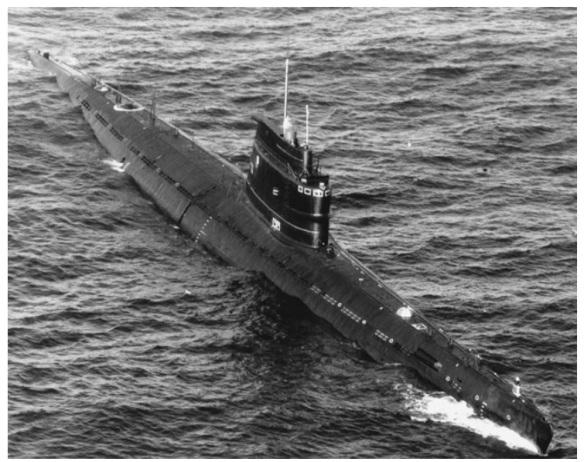A Project 611/Zulu IV showing the clean lines of this submarine. Production of this class as a torpedo-attack submarine was truncated, with the design providing the basis for the world’s first ballistic missile submarines.
The first-generation Cold War submarines of the Soviet Union and United States-including the highly specialized U. S. K-boats and the GUPPY conversions-borrowed heavily from German designs and technologies. The large number of GUPPY and Project 613/Whiskey submarines, as well as the smaller numbers of Tangs, K-boats, and Project 611/Zulu-class submarines, indicated that undersea craft would have a major role in the strategies of both the United States and the USSR in the Cold War.
During this period the role of advanced Soviet diesel-electric submarines remained largely the same as in World War II, that is, the destruction of enemy shipping and coastal defense. However, the role of U. S. submarines shifted to ASW in anticipation of Soviet exploitation of German U-boat technology and construction techniques that could flood the ocean with advanced submarines. Further, geographic factors would force Soviet submarines to reach open ocean areas through narrow straits, which, it was believed, would facilitate the use of hunter-killer submarines (SSKs) to intercept Soviet submarines en route to their operating areas.
These initial postwar submarine programs of both navies led to the creation of large submarine construction and component production industries in each nation.
Even as the Project 613/Whiskey design was being completed, in 1947-1948 TsKB-18 undertook the design of a larger submarine under chief designer S. A. Yegorov. 77 Project 611-known in the West as the Zulu-had a surface displacement of 1,830 tons and length of almost 297 feet (90.5 m). This was the largest submarine to be built in the USSR after the 18 K-class “cruisers” (Series XIV) that joined the fleet from 1940 to 1947. The Zulu was generally similar in size and weapon capabilities to U. S. fleet submarines, developed more than a decade earlier, except that the Soviet craft was superior in underwater performance- speed, depth, and maneuverability.
In addition to ten torpedo tubes with 22 torpedoes (or an equivalent load of mines), the Project 611/Zulu was intended to carry a twin 76-mm gun mount; instead, the first units were armed with a twin 57-mm anti-aircraft mount and a twin 25-mm mount. These were fitted only to the first few ships and were soon deleted. (Removing the guns increased the underwater speed by almost one knot.)
Project 611 again reflected technologies gleaned from the Type XXI U-boat, refined by Soviet designers and adapted to their requirements and limitations. For example, the power limits of available diesel engines led to the Zulu being fitted with three diesel engines to drive three propeller shafts. Project 611 was the first three-shaft submarine to be built in Russia in more than four decades. There was an effort to mount the machinery on sound-absorbing devices and other efforts were employed to reduce machinery noises.
The lead ship, the B-61, was laid down on 10 January 1951 at the Sudomekh shipyard in Leningrad. Her completion was delayed because of several defects being found in other Soviet submarines, some resulting in sinkings. Changes included the means of blowing main ballast tanks in an emergency, the hydraulic system, and strengthening the stern because of the increased vibration when all three shafts were rotating. The B-61 was launched in 1953 and accepted by the Navy on 31 December 1953, still a remarkable building time in view of the size and complexity of Project 611.
Early planning called for 30 submarines of Project 611. However, only 13 submarines were laid down at the Sudomekh yard, of which eight were delivered at Leningrad to the Navy. The other five ships were transferred in an uncompleted state through the Belomor-Baltic Canal system to the Molotovsk yard for completion. The Molotovsk yard, above the Arctic Circle near the port of Arkhangel’sk, was created by Stalin in the 1930s to produce battleships. Another 13 submarines of Project 611 were constructed at Molotovsk, the first ships to be completely built at the yard.
Of these 26 Project 611/Zulu-class sub marines, 21 went to sea as torpedo-attack craft from 1953 to 1958, and five were completed or refitted as ballistic missile submarines. The torpedo-armed units of Project 611 and the large number of the Project 613/Whiskey class became the mainstay of the Soviet submarine force during the 1950s and 1960s, well into the nuclear era.
With these new submarines would come new torpedoes, among them acoustic homing torpedoes or use against surface ships as well as submarines. Soviet interest in acoustic torpedoes began after the German U-250 was salvaged and found to have on board three T5 acoustic homing torpedoes. These became important for Allied as well as Soviet torpedo development, with British technicians being given access to the recovered T5 weapons following a specific request from Prime Minister Winston Churchill to Stalin.
After the war Soviet engineers gained access to more German torpedo technology, and in 1950 the first Soviet acoustic homing torpedo was accepted or service, the SAET-50. This weapon was rough y the equivalent of the German T5 acoustic torpedo of 1943. In 1958 the first fully Soviet-developed ASW torpedo was accepted, the SET-53. It had a peed of 23 knots, with a range of 6,560 yards (6 km); the range was soon increased with improved batteries. The SET-53M variant of 1963, which had a silver-zinc battery, had a speed of 29 knots with a ange of 15,310 yards (14 km).
While advanced diesel-electric submarines and new torpedoes were being produced in the United States and the Soviet Union from the late 1940s, more advanced concepts in submarine propulsion were also being developed.
